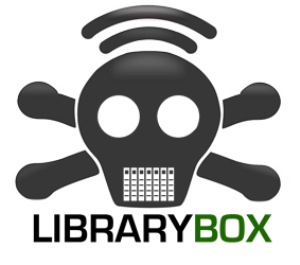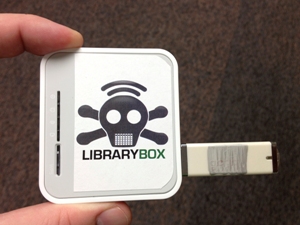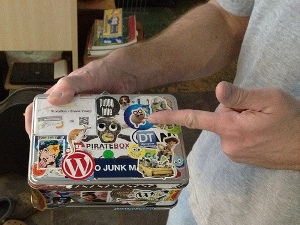 What if every ebook available from Project Gutenberg, along with songs and artwork produced within your local community, could be stored on a flash drive and be distributed wirelessly using a pocket-sized router?
What if every ebook available from Project Gutenberg, along with songs and artwork produced within your local community, could be stored on a flash drive and be distributed wirelessly using a pocket-sized router?
This technology is already available through the open source, Creative Commons and GPLv2-licensed LibraryBox project led by Jason Griffey, head of Library IT at the University of Tennessee at Chattanooga. Librarians and others are already using these devices to store and distribute ebooks, music, artwork, and other digital files. LibraryBoxes do not offer access to the Internet, but can be discovered like a standard wireless network by anyone with a smartphone or other device with wireless capabilities.
Among its many uses, it’s “a tool that libraries and educators can use to distribute things to areas where distribution of digital objects is very difficult or impossible in some instances,” Griffey said.
Or, libraries can simply use it as an inexpensive marketing tool at local coffee shops or community events.
Pirate Project
The LibraryBox is a fork of an art project called PirateBox, begun last year by New York University art professor David Darts. PirateBoxes allow anyone within wireless range to upload and download images, music, documents, videos, and other types of files in total anonymity.
Griffey thought the underlying technology could be useful to libraries, but recognized that modifications would have to be made.
“I’m guessing that most libraries are not brave enough to put up a totally anonymous file sharing box that would allow anyone to upload anything to it,” he said. “That gets really creepy really fast.”
The PirateBox project is, in part, a provocative statement about the futility of copyright laws for digital objects, Griffey explained.
“I like the underlying theme of Darts’ project, but for use in a library, I didn’t think that we needed that kind of political statement to have a useful tool,” he said. “It sounds kind of odd to say that I wanted to divorce the artistic statement from the usefulness of it, but to some degree, that’s what I was trying to do.”
So, Griffey rewrote and removed the portions of the PirateBox code that enable users to upload files to the device, and has since added several user interface customizations tailored to libraries. The result, as he explains on his blog, is “a portable, download-only digital library that can literally go almost anywhere.”
Griffey is currently working on version 2 of the software, which will feature a cleaner user interface and new functions including an image gallery, an art distribution mechanism, and possibly a chat feature.

Griffey's DIY LibraryBox is smaller than a drink coaster
Although pre-made LibraryBoxes are not available for purchase, the components are inexpensive and easy to assemble, and step-by-step instructions on the web explain how to modify the router’s firmware. Griffey’s model uses a TP-Link TL-MR3020 portable router, which retails for about $40. The only other parts are a flash drive, which can range in price from $2 to $25 based on storage capacity, and a $20 to $60 USB battery pack if outlet-free operation is a priority.
Local Distribution
Since Griffey started the project last year, he has been contacted by several librarians that have built and begun using a LibraryBox.
“The librarians that seem to attach to it and see immediate uses for it are the ones who had been struggling with something already,” he said. “Librarians who served Native American populations on reservations where there is literally no Internet access—no connectivity at all. Having this digital distribution box means that they can take it there, and that people can then—if they have an e-reader or a cellphone with Wi-Fi capability—they can pull materials off of it.”
He was also contacted by an English teacher working in a country where the Internet is heavily censored. Basic digital resources were difficult for many of the teacher’s students to access, but the LibraryBox made it possible for these materials to be distributed wirelessly in the classroom.
“I do definitely think that the underlying ethos of a library is every book its reader,” Griffey said. “The underlying ethos is that you find a way to get the information to people who need the information… If this project can help to do that in these areas, ease the difficulty in some way, I will work on it as long as I possibly can.”
At the Lake Forest Library in Illinois, Emerging Technologies and Reference Librarian Matt Neer has been using a LibraryBox to distribute out-of-copyright or Creative Commons licensed ebooks, audiobooks, as well as music from Soundcloud and the Free Music Archive. When LJ spoke with Neer earlier this month, two local artists had agreed to allow their work to be uploaded for distribution as well.
“Right now, we’re using it for a few different purposes,” Neer said. “The main one just starting out is showing people in the community that there’s another way to get ebooks from the library, and the power of what a digital environment could be like, or should be like. There’s no checkouts, no returns. You can have simultaneous users. It’s a really great platform for showing that off.”
He’s also using the LibraryBox as a tool to “create a library presence outside of the library itself,” temporarily leaving it at local coffee shops, or taking it along to local events.
“Instead of hiding it, we put it out on display. It’s this weird-looking gadget with lights beeping. So people stop by and ask about it. It is just sort of a weird concept. A local Internet, curated by all of us.”
Unfortunately, the LibraryBox code is not yet customized with a page counter, so Neer is unsure how heavily it has been used. But he said that the bookmarks and flyers that he printed up to explain the LibraryBox have been restocked twice since it went live a few weeks ago.
Digital Collections

Alan Levine took his StoryBox on a five-month roadtrip
Last year, during a five-month roadtrip around the U.S., Alan Levine, instructional technology specialist at the University of Mary Washington, showcased other possibilities for the technology with his StoryBox project.
Using an unmodified PirateBox, Levine collected digital files from friends and strangers everywhere he went, creating what he initially described as a digital time capsule. By the end, the box had stored 151 audio recordings, 18 documents, 47 songs, 927 photos, and 106 videos.
Although some contributors found the StoryBox while searching for free wireless networks, Levine said that building this collection did require some effort on his part.
“A couple of times, I would just go up to people who were working on laptops and say, ‘would you mind trying this,’” he explained. “And then, my girlfriend, who’s a designer, came up with an invitation card with the three steps for joining the network. Instead of just typing it out, she did [the instructions] as a graphic. So I would just sprinkle those cards around and see who would pick them up.”
Ultimately, much of the content that he collected was submitted by people he visited and others to whom he had time to explain the device, but about 20 percent of the files were submitted by strangers.
“That was really what was most interesting. People went through media that they had no context for, and they would ask questions…It’s very interesting when people are looking at these pictures of places, or people, or listening to audio, and not really knowing what [the context was] and being curious about it. That was one of the more fascinating parts of traveling with it.”



Effin’ brilliant! A library that will fit in my pocket. This has the potential to revolutinize our notion of what a library is.
I love this idea. Awesome marketing tool for libraries and just plain cool.
Well great ideas